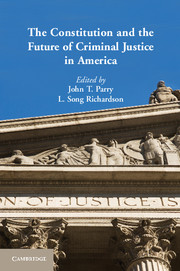Book contents
- Frontmatter
- Contents
- Contributors
- Acknowledgments
- Introduction
- Part I Foundations – The Scope of Criminal Law and Access to Counsel
- Part II Race and Criminal Procedure
- 3 The Challenges of “Quality of Life” Policing for the Fourth Amendment
- 4 Implicit Racial Bias and the Fourth Amendment
- Part III Policing and Privacy
- Part IV Technology and the Surveillance Society
- Part V Confessions and miranda
- Part VI Conviction, Sentencing, and Incarceration
- Part VII Emergencies and Borders – Immigration, Terrorism, National Security, and Transnational Crime
- Index
- References
3 - The Challenges of “Quality of Life” Policing for the Fourth Amendment
Published online by Cambridge University Press: 05 June 2014
- Frontmatter
- Contents
- Contributors
- Acknowledgments
- Introduction
- Part I Foundations – The Scope of Criminal Law and Access to Counsel
- Part II Race and Criminal Procedure
- 3 The Challenges of “Quality of Life” Policing for the Fourth Amendment
- 4 Implicit Racial Bias and the Fourth Amendment
- Part III Policing and Privacy
- Part IV Technology and the Surveillance Society
- Part V Confessions and miranda
- Part VI Conviction, Sentencing, and Incarceration
- Part VII Emergencies and Borders – Immigration, Terrorism, National Security, and Transnational Crime
- Index
- References
Summary
In New York City in the last several years, record numbers of people, overwhelmingly nonwhite, have been stopped and frisked by police. In 2009, nearly 600,000 people were stopped, 84 percent of them black or Latino. In 2010, the number of people stopped exceeded the 600,000 mark, and 87 percent of those stopped were black or Latino. Although frisks are authorized only to investigate a reasonable suspicion that a suspect is armed, only very rarely did those stops and frisks lead to discovery of a weapon. Only a small minority led to an arrest or summons. Even among those arrested, a minuscule number actually went to trial, where the legality of the police conduct could be tested. In short, under the current Fourth Amendment framework, most of that police activity was never subjected to any judicial scrutiny, either before or after it occurred, to determine whether it was legally authorized or legally carried out.
In its 1968 decision in Terry v. Ohio the Supreme Court made it clear that stops and frisks are governed by the Fourth Amendment and adopted constitutional criteria specifying when these intrusions are permissible and how they should be conducted. The Court set out to rein in the unguided discretion exercised by police in their encounters with the citizenry; a discretion that led to abuse of power, harassment, and discrimination based on race, ethnicity, and other pernicious factors. In order to impose limits on this vast category of police conduct, the Court sought not only to articulate rules for when and how police could stop and frisk the citizenry, but, crucially, to ensure that police compliance with these rules was reviewable in the courts. Even at the time, the Court recognized that its approach had limitations. It recognized that stop and frisk activity eludes judicial review when no weapon or contraband is found and no arrest is made. As it has turned out, stop and frisk and other street-level encounters between police and citizens have become increasingly insulated from court supervision, both for the reason the Court recognized and for other reasons it did not foresee.
- Type
- Chapter
- Information
- Publisher: Cambridge University PressPrint publication year: 2013
References
- 1
- Cited by

